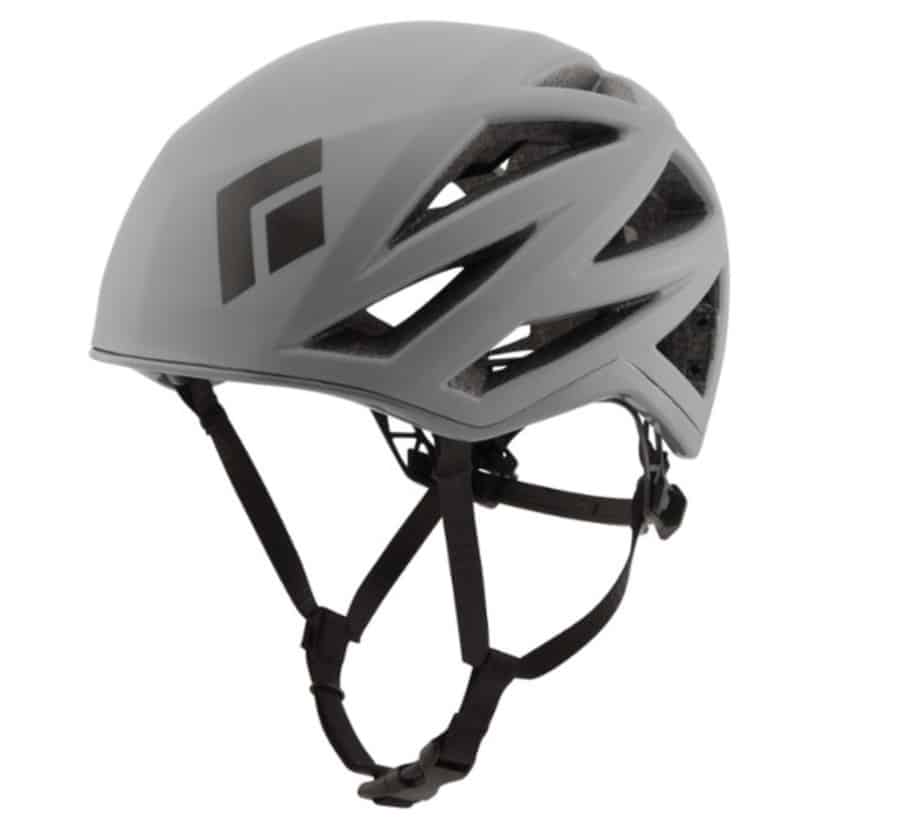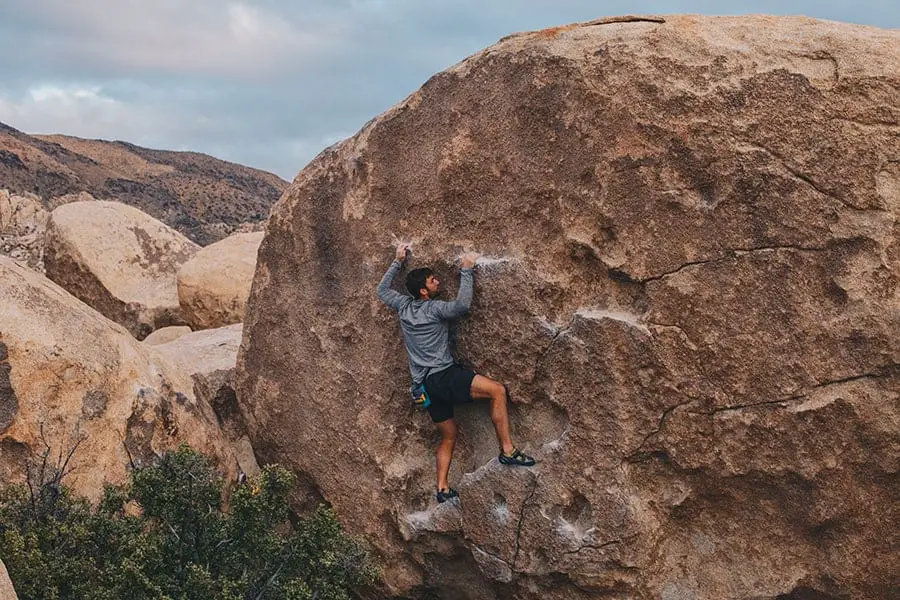After rock climbing for years, I decided to try bouldering and I noticed that most boulderers don’t wear helmets while they climb so I did some research to find out if I should.
Should you wear a helmet while bouldering? Climbing helmets are built to protect things from falling on top of your head. Since boulders are short and don’t have rocks above their heads to fall on them, you usually don’t need to wear a climbing helmet.
If you boulder outdoors by yourself (so you don’t have a spotter) and you don’t have appropriate pads, you may be wondering how to protect your head in case of a fall and hit a rock.
How To Protect Your Head While Bouldering
A great way to protect your head while bouldering is to boulder with a pad and friends that can help spot you. Spotting will ensure that you land on the mat and will minimize any chance of you hitting your head.
Most boulders don’t wear helmets while bouldering and some climber have even reported feeling silly or being teased for wearing a helmet while bouldering. However, there is still a chance that you can hit your head so additional precautions can be taken. Especially if you are bouldering by yourself.
Climbing Helmets Aren’t Ideal For Bouldering
Most climbing helmets are built as an evolution of a hard-hat that protects the top of your head in case rocks or something else falls on you or your hit your head on an overhang. Which is an important feature for people rock climbing.
This, however, makes them less than adequate protection for falling while bouldering. If you fall while bouldering the risk of hitting your head would likely be to the back of your head, a place not well protected by climbing helmets.
What Helmets Are Ideal For Bouldering
There aren’t specific helmets for bouldering, however, you can wear helmets that are specific for protecting the back of your head.
A BMX or skating helmet, for example, won’t be good at protecting you from falling rocks, but they are made specifically for protecting the back of your head, the sides of your head and even your forehead.
Boulders that wear a helmet often mention that they feel safer and more comfortable making bigger moves while bouldering outdoors. And it doesn’t hurt to wear a helmet, so it might be worth trying.
Should You Wear A Helmet While Bouldering Indoors?
Most bouldering gyms have significant padding around the fall zone of boulders making it unlikely for a head injury to occur. In addition, since there aren’t any rocks to hit your head on, you are likely just as safe without a helmet, as you are with a helmet.
Not considering someone kicking you in the head or falling on you, which you can avoid by paying attention to your surroundings.
Do Rock Climbers Wear Helmets?
Because of the risk involved, climbers should always wear a helmet while climbing and belaying outdoors.
The use of a climbing helmet is to protect climbers from any rocks that may fall on them. For alpine, ice climbing and big-wall climbing, the likelihood of rocks falling on you is high. In comparison, rocks breaking off or weather blowing rocks on top of you while climbing a shorter wall is less likely.
However, a climber is still safer if they are wearing a helmet. In addition, the belayer should also be wearing a helmet, as they are at the same risk a climber is, if not at a higher risk because the climber may break rocks while they are climbing and those rocks may fall on the belayer.

Do Climbers Wear Helmets While Climbing Indoors?
Most climbing gyms don’t require you to wear a helmet. Since indoor climbing walls are artificial, it is unlikely for rocks to fall on your head. In addition, many climbing gym routes are made in a way that minimizes hitting your head on an overhand or from falling.
Can I Use A Bike Helmet For Climbing?
Climbing helmets are an evolution of a hard hat, which is made to protect your head from hard and heavy things to fall on your head such as rocks. Whereas, biking helmets are meant for falls off of a bike and arent’ built with the protection needed in climbing.
The Basic Make and Function Of A Climbing Helmet
Climbing helmets are made with a thick/hard external shell, a padded area and additional plastic straps that create space between the top of your head and the top of the helmet.
This structure makes it so that if something hard falls on your head, your head will have a hard shell to break the fall, a gap between the head and that shell with padding so that the impact is minimized and unlikely to hurt your head.
The Basic Make and Function Of A Bike Helmet
A bike helmet is made to protect your head if you fall off your bike and hit your head.
It is built with a thin shell that covers foam and padding. The padding would help prevent injury when you fall, but it is also made to break, similar to how a car is built to crumble to minimize the impact.
This means that it isn’t built for a hard impact of a rock and would likely crack if something falls on it. In comparison, a climbing helmet would withstand the impact of a rock falling on it so you can use it over and over again.
With that being the case, a bike helmet is not adequate for climbing and you should consider purchasing a climbing helmet to ensure your safety.
How Should A Climbing Helmet Fit?
Most climbing helmets have three sizes, Kids, Small/Medium and Medium/Large. To identify what climbing helmet size you should purchase, first measure the circumference of your head and compare it to the sizing range provided by the product/brand. Once you identify the size helmet you need, the following is what you need to know for the right fit.
There are two main elements of how a climbing helmet should fit, the forehead rim and the chin strap. When fitted correctly, there shouldn’t be any movement in the helmet when you shake your head from side to side or up and down.
How The Rim Should Fit
To ensure the correct fit, start with the rim around your head. Most climbing helmets have adjusting nobs at the back of the helmet that allows you to adjust the tightness of the rim. Once the rim is tight enough that the helmet doesn’t move when you shake your head from side to side, it is fitted correctly and you can move onto the chin strap.
How The Chin Strap Should Fit
The chin strap should fit under your chin without any slack between your chin and your ears. Tighten the chin strap until your helmet stays in place while you shake your head up and down.
With the rim and chin strap properly adjusted, you can test it by shaking your head back and forth as well as up and down. If it doesn’t move out of place, then it is fitted correctly.
Related Questions:
How Long Do Climbing Helmets Last
Most climbing helmets last 10 years, however, each manufacture provides a recommended lifespan for their products. In addition, if the climbing helmet shows indications of cracking or cracks from impact, it should be retired and replaced.
How Much Do Climbing Helmets Cost
Depending on the material, weight, ventilation, accessory features and branding, they range from $30-$150. Helmets that are lightweight, well ventilated and have options for a visor or headlamps usually cost over $70.
More Buyer’s Guides:
- The Top 5 Crash Pads For Bouldering: How To Decide Which Is Best
- Diy Hangboard With Jugs And Edges For Less Than $15
- 6 Of The Best Belay Devices For Beginner Climbers
- The Best 11 Climbing Shoes Under $100
- Climbing Chalk: Chunky Vs. Fine
- The Best Chalk For Climbing And Bouldering
- Rock Climbing Starter Kits For Beginners Compared
- Liquid Chalk Vs. Dry Chalk For Bouldering (Hint: Dry Chalk Is Better)
- Top 5 Gear You Need In Your Climbing Pack For The Best Experience
- What To Wear While Bouldering
- Should You Upgrade To An Assisted-Braking Belay Device?
- Everything You Need To Know About Climbing Chalk
- 37 Things Serious Climbers Bring With Them To The Mountains
- Clothing For Climbing In The Gym – What Should You Wear?
- Can You Climb Without Chalk?
- How Tight Climbing Shoes Should Fit For The Best Performance
- Harnesses For Rappeling
- My Favorite Harness For Climbing
- What You Should Wear While Climbing
- What Affects How Climbing Shoes Fit?
- How To Clean Your Grigri
- How To Care For Your Climbing Rope
More About Bouldering:
- What Is The Minimal Gear Needed For Bouldering?
- Can You Boulder Alone? The 8 Benefits Of Climbing Alone
- The Complete Guide For Bouldering Grades – What You Should Know
- Should You Wear A Helmet For Bouldering?
- Can You Boulder In The Rain Or When The Rock Is Wet?
- First Time At The Bouldering Gym – What You Should Know
- Pros And Cons Of Indoor Bouldering
- Indoor Bouldering: Do’s And Don’ts For Beginners
- Bouldering For Beginners: What You Need To Know
- A Guide For Climbers: Bouldering Drills 101
- Is Climbing and Bouldering Good For Cardio?


